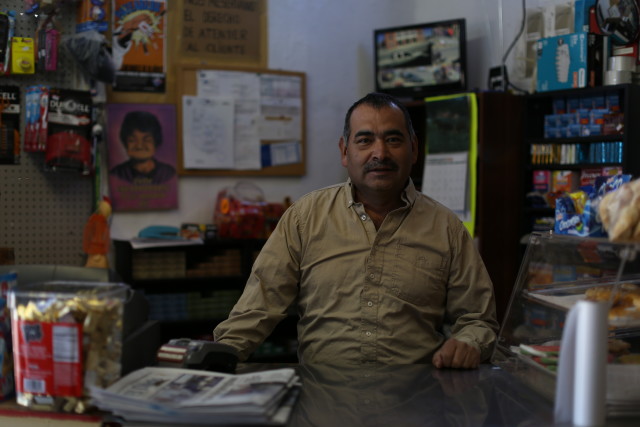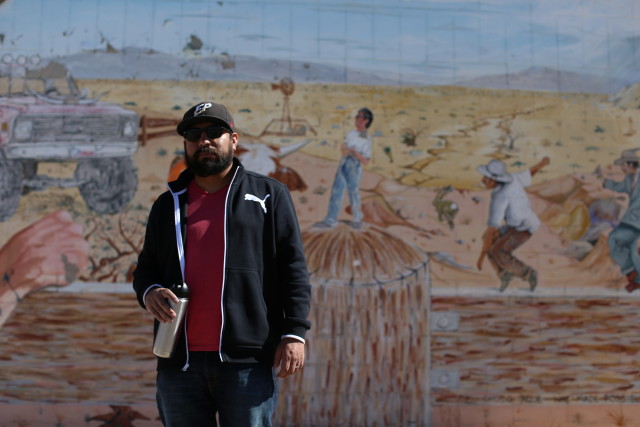In El Paso’s Segundo Barrio, Pope’s Message Has Special Relevance
By Travis Putnam Hill
Reporting Texas

Evangelina Terrones closed her grocery story early Wednesday in El Segundo Barrio. Business was slow because so many people were focused on the pope’s visit just across the border in Juarez. Daulton Venglar/Reporting Texas
For Reporting Texas
EL PASO — When Pope Francis celebrated Mass Wednesday in Juárez, another audience watched from the other side of the U.S.-Mexico border. Across the Rio Grande River, several hundred yards from Juárez, residents and visitors in the Segundo Barrio, one of El Paso’s oldest neighborhoods, gathered to catch even a glimpse of the pope.
Some climbed trees for a better view. When the pontiff emerged on a platform at the border to bless onlookers in the United States, people here raised their phones and cameras to capture the moment.
“Everyone got excited and was yelling, raising their arms, taking pictures,” said Pablo López, president of El Paso’s South Side Neighborhood Association. “It was a once-in-a-lifetime deal for a lot of us.”
The pope’s call for mercy toward the poor and an end to the exploitation of immigrants resonated in the Segundo Barrio (“the second ward”). In this predominantly Hispanic pocket of South El Paso, generations of families, both U.S.-born and immigrant, have built a tightly knit community and a rich cultural history despite economic hardship.

A U.S. Customs and Border Patrol vehicle passes through the streets of Segundo Barrio. Daulton Venglar/Reporting Texas
“The [pope’s] visit is very important for us in the sense that we always have said that the border is the Holy Land,” said Carlos Marentes, director and founder of the Border Agricultural Workers Center, a local organization that provides farm workers a place to rest, eat, and wash between their shifts in the fields.
“This is the border that continues to suffer violence, that continues to suffer poverty. It’s a land that has been fed with the blood of many persons, victims of violence,” Marentes said. “The visit of the pope, Pope Francis, to this border area … is the realization that this is truly the Holy Land for us.”
Sergio “Red” Romo spent much of the day at a cookout with neighbors outside the home of his 95-year-old mother. They had carried a television out front to the sidewalk, to watch the papal Mass as was televised from Juárez.
“Most of us are Catholic, so we want it. We want to hear the blessing from the pope across the border,” said Romo, a lifelong resident of the neighborhood.

Benito Pérez is the owner of La Tiendita, a market in the Segundo Barrio neighborhood of El Paso. Daulton Venglar/Reporting Texas
The Segundo Barrio makes up less than a square mile of South El Paso and has a population of about 6,000, according to City-Data.com, which compiles statistics about U.S. cities. Its southern boundary is the Cesar Chavez Border Highway, which is only several railroad tracks away from the border fence and the Rio Grande. Single-story houses and two-story apartments, most of them pre-World War II, make up much of the neighborhood. In recent years, the city has made efforts to revitalize the neighborhood, and some new housing has been built. But that has brought some gentrification, as evidenced by several multistory construction projects on the outskirts.
The median household income in the neighborhood is just over $13,000 a year, but many families earn less than that. A 2010 City of El Paso report found that 62 percent of the population lived below the federal poverty line.
But poverty does not define the Segundo Barrio. The neighborhood is known for its communal hardiness and cultural wealth — an identity expressed in part by the vibrant murals throughout the area.
Jesus “Cimi” Alvarado, the artist behind many of the murals, grew up in the neighborhood.
One of his murals, “El Corrido del Segundo Barrio,” comprises several scenes depicting life in the neighborhood. One scene shows three men walking toward the Puente Negro railroad bridge, an international crossing where many a migrant would huddle alongside the tracks on the Mexico side, waiting for the metal gates to swing open for an approaching train – an opportunity for a sprint into the United States.

Jesus “Cimi” Alvarado is a local muralist and arts educator who teaches classes at schools in the Segundo Barrio neighborhood of El Paso. Daulton Venglar/Reporting Texas
As a child, Alvarado said he sometimes watched dozens of people rushing though the gates into his neighborhood. Some escaped capture by the Border Patrol, he said; others did not.
He also recalled seeing people pop up through manholes in the streets, after making their way across the border and crawling through sewer pipes under El Paso streets to avoid detection from Border Patrol agents.
Two Catholic churches, Sacred Heart and St. Ignatius, form part of the bedrock of the neighborhood. One street is named after Father Harold Rahm, a priest who served the area in the 1950s and 1960s and is known as the “bicycle padre” because he rode through the neighborhood trying to discourage young people from joining gangs.
In the days before the pope’s visit, parishioners came daily to a temporary shrine at Sacred Heart to pray for his safe arrival. On Monday, El Paso Bishop Mark Seitz sat outside St. Ignatius passing out free tickets to the livestream of the Mass at the University of Texas at El Paso’s Sun Bowl stadium.
On Wednesday, schools and some businesses were closed. So many people had gone to the stadium or to Juárez that business was slow at some local stores. Nachita’s Grocery closed at 4:30. “It was pretty slow,” said Evangelina Terrones, the third-generation owner. “Tomorrow, it will be back to normal.”
Reflecting on the day’s cross-border theme, López said Thursday that he thinks the pope’s message will have a lasting influence on the people who heard it.
“I hope for the better, for our sister city Juárez and us, that we wake up to the issues we have – like immigration, simply getting along and stopping the violence,” he said.